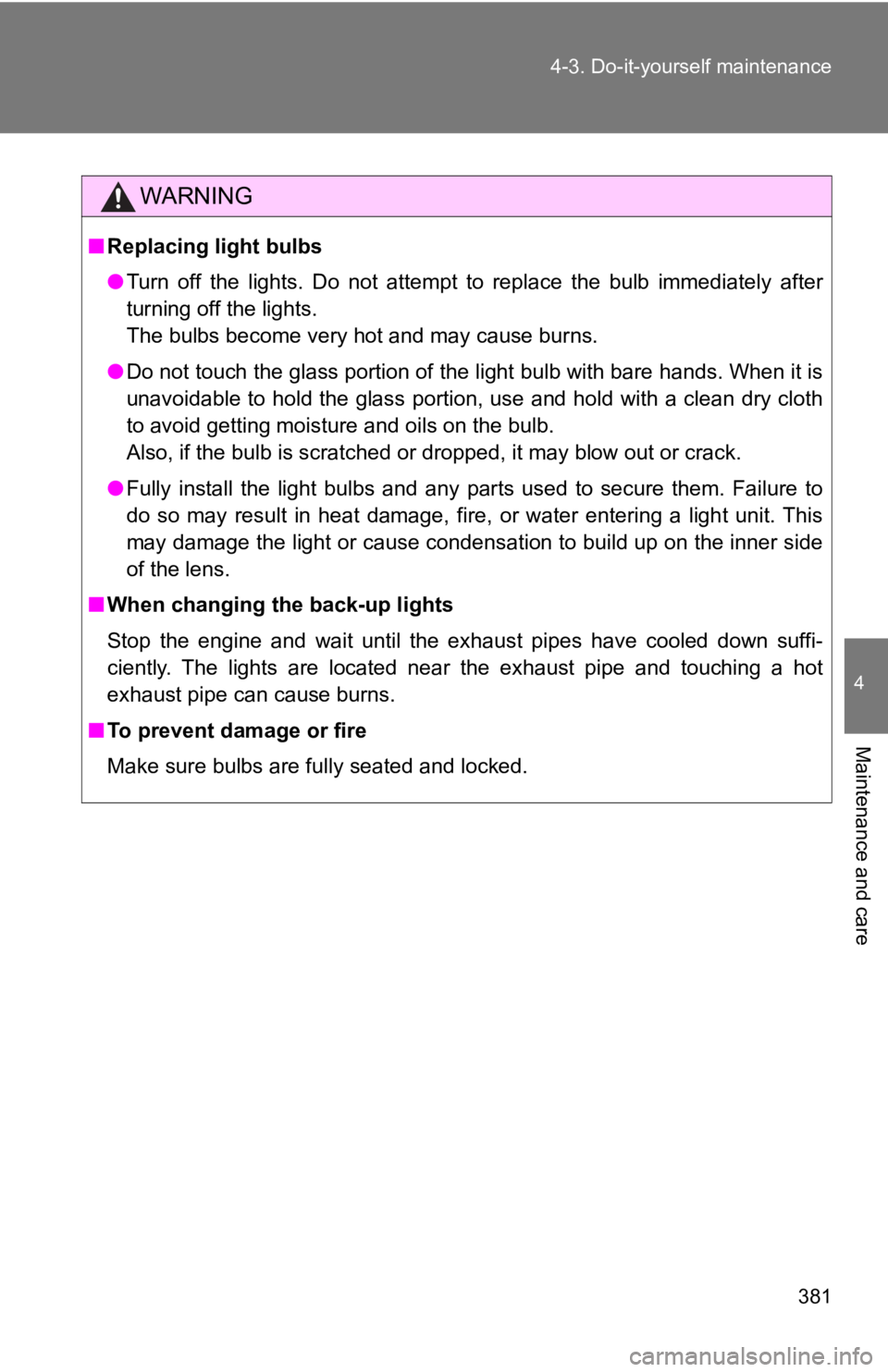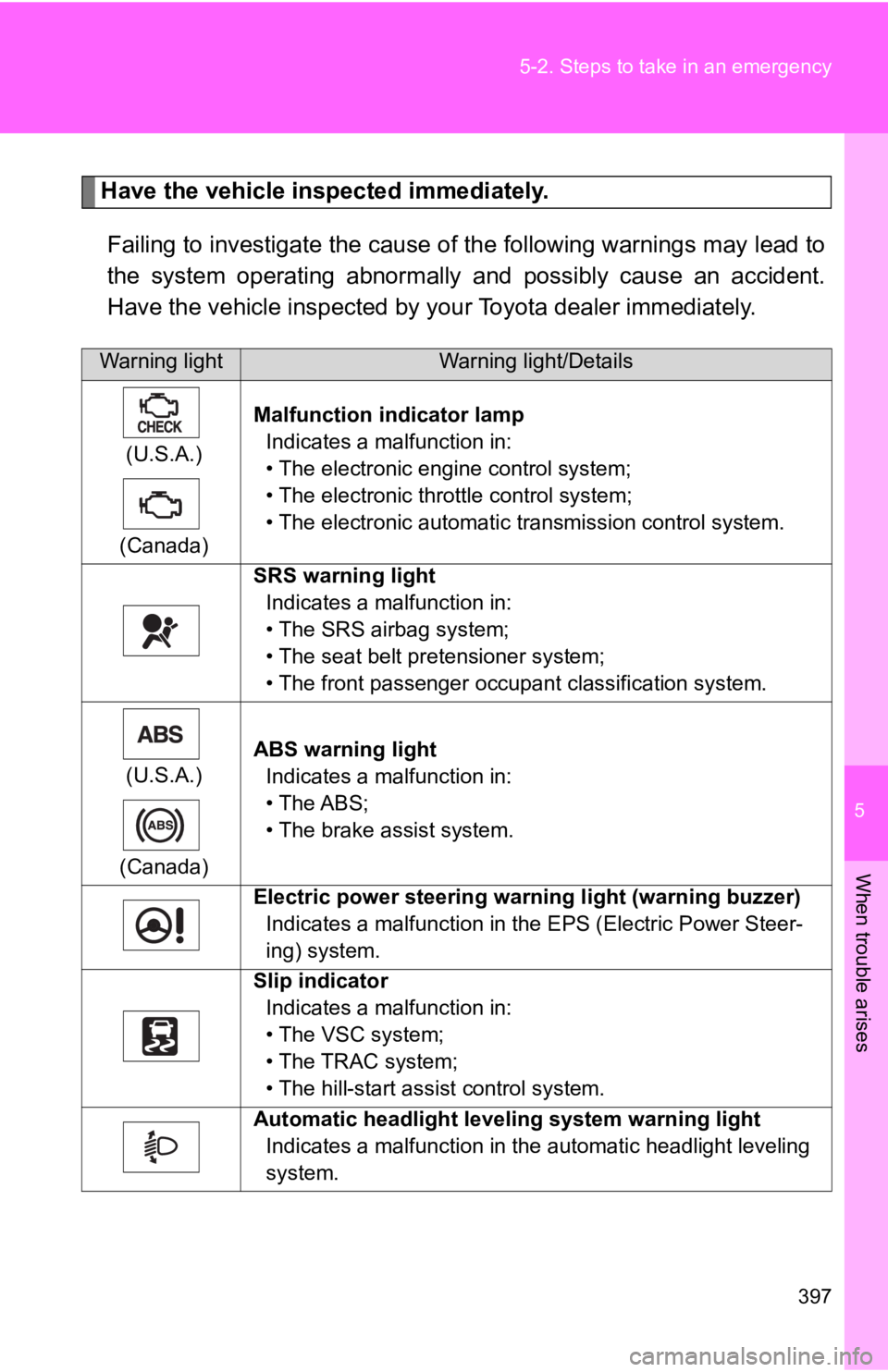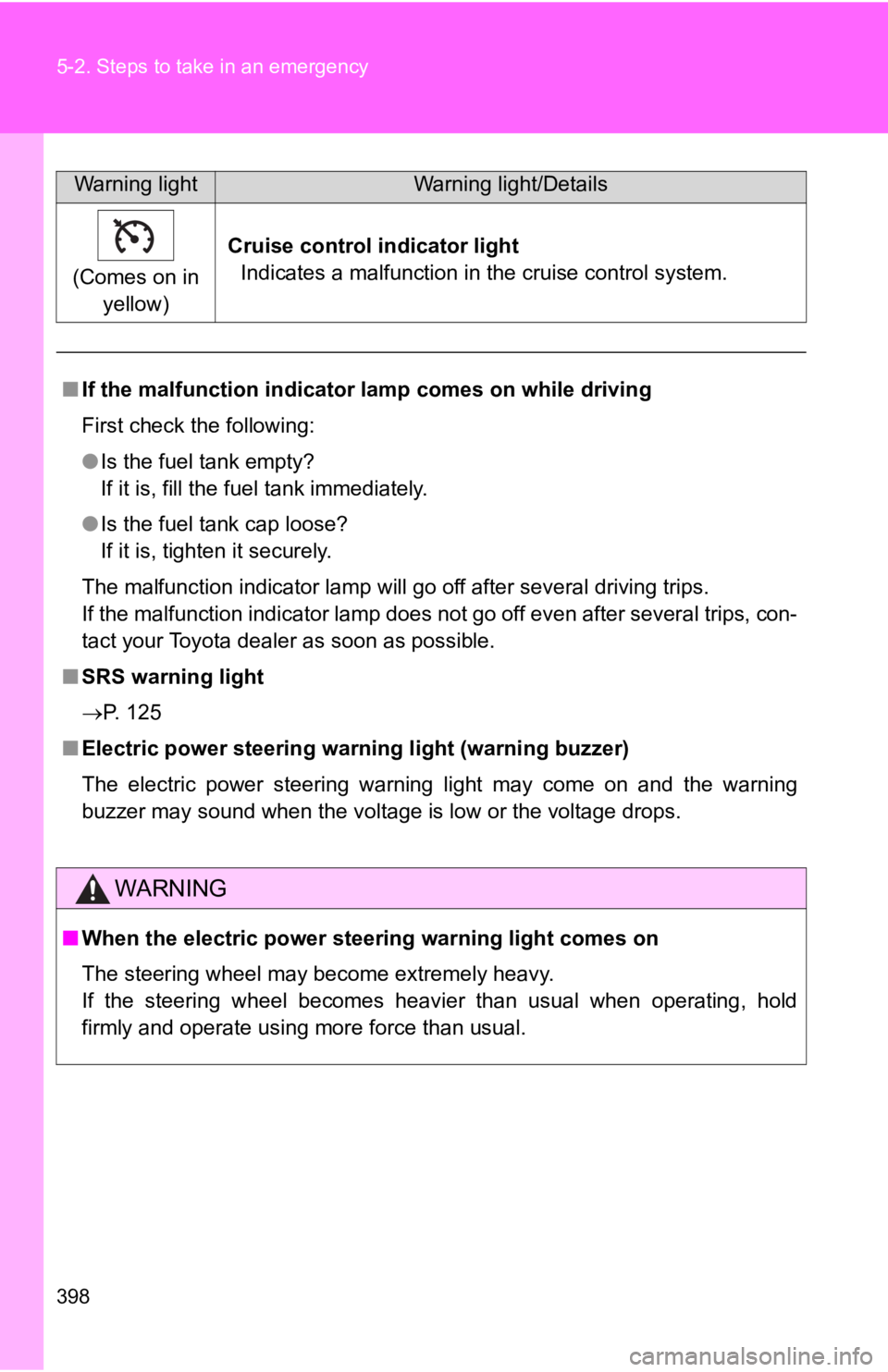Page 347 of 532

347
4-3. Do-it-yourself maintenance
4
Maintenance and care
■When to replace your vehicle’s tires
Tires should be replaced if:
●The treadwear indicators are showing on a tire.
●You have tire damage such as c
uts, splits, cracks deep enough to
expose the fabric or bulges indicating internal damage
●A tire goes flat repeatedly or cannot be properly repaired due to the
size or location of a cut or other damage
If you are not sure, consul t with your Toyota dealer.
■Replacing tires and wheels
If the ID code of the tire pressure warning valve and transmitt er is not
registered, the tire pressure w arning system will not work prop erly. After
driving for about 20 minutes, t he tire pressure warning light c omes on
after blinking for 1 minute to indicate a system malfunction.
■Tire life
Any tire over 6 years old must be checked by a qualified techni cian even
if they have seldom or never b een used or damage is not obvious.
■If the tread wears down below 0.16 in. (4 mm) on snow tires
The effectiveness of snow tires is lost.
■Low profile tires
Generally, low profile tires will wear more rapidly and tire gr ip perfor-
mance will be reduced on snowy and /or icy roads when compared to
standard tires. Be sure to use snow tires or tire chains on sno wy and/or
icy roads and drive carefully at a speed appropriate for road a nd weather
conditions.
Page 374 of 532
374 4-3. Do-it-yourself maintenance
■After a fuse is replaced
●If the lights do not turn on even after the fuse has been repla ced, a bulb
may need replacement. ( P. 375)
● If the replaced fuse blows again, have the vehicle inspected by your
Toyota dealer.
■ If there is an overload in the circuits
The fuses are designed to blow, protecting the wiring harness from damage.
WARNING
■To prevent system breakdow ns and vehicle fire
Observe the following precautions.
Failing to do so may cause damage to the vehicle, and possibly a fire or
injury.
● Never use a fuse of a higher amperage rating than indicated, or use any
other object in place of a fuse.
● Always use a genuine Toyota fuse or equivalent.
● Do not modify the fuse or the fuse box.
NOTICE
■Before replacing fuses
Have the cause of electrical overload determined and repaired b y your
Toyota dealer.
Page 381 of 532

381
4-3. Do-it-yourself maintenance
4
Maintenance and care
WARNING
■
Replacing light bulbs
●Turn off the lights. Do not attempt to replace the bulb immedia tely after
turning off the lights.
The bulbs become very hot and may cause burns.
● Do not touch the glass portion of the light bulb with bare hand s. When it is
unavoidable to hold the glass portion, use and hold with a clea n dry cloth
to avoid getting moisture and oils on the bulb.
Also, if the bulb is scratched or dropped, it may blow out or c rack.
● Fully install the light bulbs and any parts used to secure them . Failure to
do so may result in heat damage, fire, or water entering a light unit. This
may damage the light or cause condensation to build up on the i nner side
of the lens.
■ When changing the back-up lights
Stop the engine and wait until the exhaust pipes have cooled do wn suffi-
ciently. The lights are located near the exhaust pipe and touching a hot
exhaust pipe can cause burns.
■ To prevent damage or fire
Make sure bulbs are fully seated and locked.
Page 383 of 532
When trouble arises5
383
5-1. Essential informationEmergency flashers ......... 384
If your vehicle needs to be towed ........................ 385
If you think something is wrong ......................... 393
Fuel pump shut off system ........................... 394
5-2. Steps to take in an emergency
If a warning light turns on or a warning buzzer
sounds... ........................ 395
If a warning message is displayed........................ 407
If you have a flat tire......... 424 If the engine will
not start .......................... 435
If the shift lever cannot be shifted from P................. 438
If you lose your keys ........ 439
If the electronic key does not operate properly....... 440
If the battery is discharged ..................... 444
If your vehicle overheats ....................... 449
If the vehicle becomes stuck .............................. 452
If your vehicle has to be stopped in an
emergency ..................... 454
Page 395 of 532
5
When trouble arises
395
5-2. Steps to take in an emergency
If a warning light tur ns on or a war ning buzzer sounds...
Stop the vehicle immediately. Continuing to drive the vehicle
may be dangerous.
The following warning indicates a possible problem in the brake sys-
tem. Immediately stop the vehicle in a safe place and contact y our
Toyota dealer.
Warning lightWarning light/Details
(U.S.A.)
(Canada) Brake system warning light
• Low brake fluid
• Malfunction in the brake system
This light also comes on when the parking brake is not
released. If the light turns off after the parking brake is ful ly
released the system is operating normally.
Calmly perform the following acti ons if any of the warning lights turn
on or flash. If a light turns on or flashes, but then turns off , this does
not necessarily indicate a malfunction in the system.
Page 396 of 532
396 5-2. Steps to take in an emergency
Stop the vehicle immediately.The following warning indicates the possibility of damage to th e vehi-
cle that may lead to an acciden t. Immediately stop the vehicle in a
safe place and contact your Toyota dealer.
Warning lightWarning light/Details
Charging system warning light Indicates a malfunction in the vehicle’s charging system.
Low engine oil pressure warning light Indicates that the engine oil pressure is too low.
(Flashes or illu- minates in red) High engine coolant temper
ature warning light (if
equipped) Indicates that the engine is almost overheating. ( P. 449)
As the engine coolant temperature increases, this warning
light will change from flashing to constantly illuminated.
Page 397 of 532

5
When trouble arises
397
5-2. Steps to take in an emergency
Have the vehicle ins
pected immediately.
Failing to investigate the cause of the following warnings may lead to
the system operating abnormally and possibly cause an accident.
Have the vehicle ins pected by your Toyota dealer immediately.
Warning lightWarning light/Details
(U.S.A.)
(Canada) Malfunction indicator lamp
Indicates a malfunction in:
• The electronic engine control system;
• The electronic throttle control system;
• The electronic automatic transmission control system.
SRS warning light Indicates a malfunction in:
• The SRS airbag system;
• The seat belt pretensioner system;
• The front passenger occupant classification system.
(U.S.A.)
(Canada) ABS warning light
Indicates a malfunction in:
• The ABS;
• The brake assist system.
Electric power steering warning light (warning buzzer) Indicates a malfunction in the EPS (Electric Power Steer-
ing) system.
Slip indicator Indicates a malfunction in:
• The VSC system;
• The TRAC system;
• The hill-start assist control system.
Automatic headlight leveling system warning light Indicates a malfunction in the automatic headlight leveling
system.
Page 398 of 532

398 5-2. Steps to take in an emergency
(Comes on in yellow) Cruise control indicator light
Indicates a malfunction in the cruise control system.
■ If the malfunction indicator lamp comes on while driving
First check the following:
●Is the fuel tank empty?
If it is, fill the fuel tank immediately.
● Is the fuel tank cap loose?
If it is, tighten it securely.
The malfunction indicator lamp will go off after several driving trips.
If the malfunction indicator lamp does not go off even after several trips, con-
tact your Toyota dealer as soon as possible.
■ SRS warning light
P. 125
■ Electric power steering warning light (warning buzzer)
The electric power steering warning light may come on and the w arning
buzzer may sound when the voltage is low or the voltage drops.
WARNING
■ When the electric power steer ing warning light comes on
The steering wheel may become extremely heavy.
If the steering wheel becomes heavier than usual when operating , hold
firmly and operate using more force than usual.
Warning lightWarning light/Details